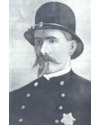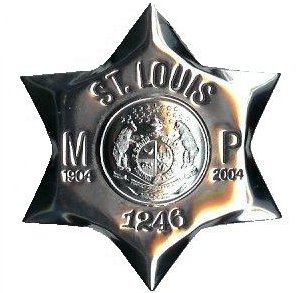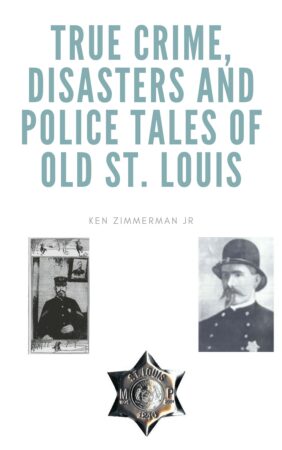Toughest Saloon on Deep Morgan
On October 6, 1890, local barbers Luther Duncan and Bob Henderson stepped out on to N. 11th Street to settle a quarrel. This area of St. Louis was known as “Deep Morgan”. “Deep Morgan” was home to bordello, flop houses and the toughest African-Americans saloon in the city, Starkes’ Saloon. Both Duncan and Henderson were black barbers, who worked in the barber shop next to Starkes’ Saloon.

Patrolman James Brady
Duncan and Henderson decided to settle their disagreement in a fist fight. Duncan’s and Henderson’s fight gathered a large crowd. Several persons ran to St. Louis Patrolman Gaffney to report the fight. Gaffney arrived at the scene and ordered Duncan, Henderson and the crowd to disperse.
Henderson followed Gaffney’s direction but Duncan refused to leave. When Gaffney put his hand on Luther Duncan’s arm to arrest him, Luther’s brother William Henry Harrison Duncan, known locally as Harrison Duncan, struck Gaffney in the face.
Harrison and Luther Duncan proceeded to pummel Gaffney before tossing him out of the crowd. As Gaffney was stumbling, several members of the crowd kicked him.
Gaffney drew his revolver and fired two shots in the air to disperse the crowd and get the attention of officers on adjoining beats. Harrison Duncan struck Gaffney again.
Luther Duncan took Gaffney’s club and struck Gaffney in the head several times before dropping the club at Gaffney’s feet. The Duncans and several members of the crowd retired to Starkes’ Saloon.

Early St. Louis Police Badge from the Public Domain
Gaffney regained consciousness and staggered into Starkes’ Saloon. He saw Luther Duncan playing pool on a raised platform on the west side of the saloon. Gaffney called to Luther Duncan with his gun in his hand and told him that he was under arrest.
Whether it was the gun in Gaffney’s hand or Luther Duncan thought things had gone far enough, he submitted to Gaffney’s arrest. Harrison Duncan was not quite through.
Duncan smashed Gaffney over the head with a pool stick, took his revolver and pushed him down the north stairs to the platform. Harrison Duncan ran for the south stairs and began to head towards the exit.
St. Louis Police Officer Maloney and Conners entered the building as Harrison Duncan was coming down the south stairs with Gaffney’s revolver in his hand. They ordered him to surrender. Duncan fired two shots at Maloney and one at Conners, who returned fire.
Duncan took cover behind the bar. Harrison Duncan popped up occasionally and shot at the officers, who returned fire. St. Louis Patrolman James Brady entered Starkes’ Saloon. Brady walked to the bar and ordered Harrison Duncan to surrender. Duncan refused and Brady leaned over the bar firing a shot at Duncan that missed. Harrison Duncan popped up and shot Brady, who fell dead.
However, Maloney and Conner were able to hit Duncan finally although the wounds were minor to his side. After he was shot, Duncan tried to crawl from the bar but Conners covered him. After two commands to drop the revolver or be shot, Duncan finally surrendered and was secured by Conners.
The facts from this case were taken from the Supreme Court case on the murder. Harrison Duncan would tell a different story at trial that would lead to a popular ballad but that is a story for a future post.
You can leave a comment or ask a question about this or any post on my Facebook page and Twitter profile.
Pin It

